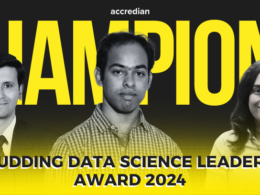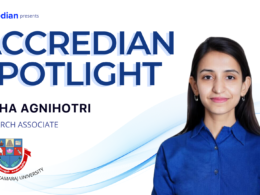![]() Here is an article by one of our Top 5 Budding Data Scientists, Anirudha Acharya. Read about the scope of Data Science based systems and applications in the insurance industry.
Here is an article by one of our Top 5 Budding Data Scientists, Anirudha Acharya. Read about the scope of Data Science based systems and applications in the insurance industry.
Data Science is the fastest-growing science and technology-related job in the current world. This is primarily because it employs techniques and theories drawn from many fields within the context of mathematics, statistics, computer science, and information science. With the advancement in the processing powers of computers (simple RAMs to advanced GPUs) and also the availability of huge corpus of data, lying with corporations from many decades which is growing exponentially every day, its highly important for the current generation to use this huge collection of data, although unstructured, to build meaningful insights in making more informed decision for the future of each and every business space. 
What lies ahead of us is a highly automated systems using sophisticated applications making day to day process easier. With the advancement of AI, the scope of such systems/applications are multifold, making Data Science, Machine Learning and AI the most sought-after job of our generation.

One would wonder why and how Data Science garnered this magnitude of hype. As we always knew, the magnitude of ‘Data’ every business already possesses, and existence of ‘Science’ was from the beginning of time. Scientists and Mathematicians had derived the concepts decades before this “hype” eventually began. It is the ‘Data Science’ which brought these two together making it the most capable dimension of the whole analytics world. No wonder, it is the ‘potential’ that Data Science brings in on the table which separates it from the hype.
The potential of Data Science is such that any simple application based on it, be it an email spam detection or YouTube recommendation (although, there are highly complicated algorithms running in the background) makes it fascinating to the end user and attracts us towards it. More complicated applications such as cancer detection, self-driving cars, chatbots, Alphago and NASA’s AEGIS makes one wonder about the capacity this domain holds.
Moving on, the applications of Data Science are vast spread and interestingly, with the current day and age, it would not be an exaggeration to say almost all businesses and industries are trying to reap the benefits of Data Science, starting from their day to day activities to customer experiencesData Scienceers have already succeeded in this endeavor.

We shall discuss more about the Data Science application in the BFSI industry and in particular, Insurance industry, which is broadly classified into i) Life insurance and annuities, ii) Auto insurance, iii) Property insurance and iv) Healthcare insurance.
First, let us see the applications benefiting all the sub categories. Data Science has its presence through out the insurance life cycle, right from product selection through policy issue to claim settlements. Applications such as fraud detection, customer segmentation, price optimization, recommendation engines, lifetime value prediction, claims prediction, risk assessment and automated life-event marketing are adding the much-needed value to the new business models in comparison with the traditional models.
While, applications such as customer segmentation are guiding the insurance companies in segmenting the customers in groups, based on various customer attributes, ultimately leading in new product development. Different customers tend to have specific expectations for the insurance. Insurance marketing applies various techniques to increase the number of customers and to assure targeted marketing strategies. In this regard, customer segmentation proves to be a key method. Customers are classified into groups by spotting similarities in their attitude, preferences, behavior, or personal information, thus allowing the development of products specific to a segment and also brings in cross-selling.
The price optimization and lifetime value prediction applications are guiding the insurance actuaries in determining the ‘good risks’ and also, the right price for the product using the mortality, morbidity values. In other words, historical costs, expenses, claims, risk, and profit are projected into the future. Special algorithms give the insurers the opportunity to adjust the quoted premiums dynamically. Price optimization is in close relation with the customer’s price sensitivity by taking into consideration the price changes in comparison with the previous policy year.

Recommendation engines are helping the product end user in finding the good product which he is interested in and recommends the best fit product for the user taking considerations of customer’s day to day decisions, choices, and preferences. Based
on these insights, the engines generate more targeted insurance propositions tailored for specific customers, filtering specific preferences and peculiarities in customer choices.

Automated life-event marketing is the modern business strategy to attract as many customers as possible through multiple channels. The main goal is to reach the right person with the right message at the right time and life-event marketing is about the special events in a customer’s life. Using Data Science techniques, the insurers collect the data from multiple channels and detect special dates and celebrations. Then, complex algorithms and associations, targeted suggestions and strategies are applied.
The basic concept of any insurance is transfer of risk. While the customers transfer their risk to the insurer, the insurer absorbs these risks. But, to run a successful business, the insurer also must perform an in-depth risk assessment and models provide a systematic approach to risk information, both actual risk and speculative risk, in real-time. The risk assessment process is used to bring balance to the company’s profitability and to avoid both these types of risks.
Potential risks are analyzed, and the company’s risk is forecasted through the prediction of the exposure group risks. Companies make informed decisions based on these risk predictions to increase profitability.
Fraud detection is becoming one of the top priorities, as such activity leads to high losses to the company. Data Science applications have made it possible to detect fraudulent activity, suspicious links, and subtle behavior patterns using previous cases of fraudulent activity and apply sampling method to analyze them. Predictive models analyze and filter the fraud instance creating an inference for activities that were not noticed earlier.

After having absorbed the risks from the customers, the insurance company would want to perform claims prediction to predict the future payments and settlements. Complex Data Science methodologies are used for this. A high number of different attributes are analyzed for this purpose.

With the advancement in technology and current market requirements, many advanced auto insurance models are developed. In an SAS white paper, Telematics: How Big Data is transforming the Auto Insurance Industry, the authors highlight two of these options:
- PAYD: Pay-As-You-Drive
- PHYD: Pay-How-You-Drive
PAYD is straightforward. It charges customers based on the number of miles or kilometers driven. Hollard Insurance, a South African insurer, has six mileage options.
But, PAYD does not take into account driving habits. PHYD plans use telematics to monitor a wide variety of factors – speed, acceleration, cornering, braking, lane changing, fuel consumption – as well as geolocation, date and time. If an accident occurs, the insurance company can recreate the situation.

In a move similar to auto, property insurance companies are assessing how they can use telematics to create usage-based home insurance. These data sources can include Moisture sensors that detect flooding or leaks, utility and appliance usage, security cameras and sensors that track occupancy. Combine this with information from outside sources (e.g., local crime reports and traffic) and you can arrive at a comprehensive assessment of one person’s property claim risk as well. Going further, these sources can be used to protect a customer. For example, with predictive Data Science models, insurers can calculate the likelihood of an event such as theft and take steps to avoid pain and suffering, as well as, big claims.

We live in a monitored world. Health insurance companies know this more. To create profiles of customer health and develop individual well-being scores, insurers are now expanding the information net very wide to collect the much important data. They can collect transactional data, e.g., where and what food customers buy, body sensors, i.e., devices that monitor consumption or alert the user to early signs of illness, exterior monitors, e.g., data from workout machines, social media, e.g., tweets about one’s personal health or state of mind, and also these health insurance companies are very much interested in any data that hospitals could provide them.
Modern technologies are moving extremely fast making their ways into various fields of the business. In this respect, the insurance industry does not lack behind the others. The application of statistics in the insurance has a long history. Thus, the fact that insurance companies are actively using Data Science and analytics is highly impressive. The aim of applying data science and analytics in the insurance industry is the same as in the other industries, to optimize marketing strategies, to improve the business, to enhance the income, customer satisfaction and to reduce costs.
As we discussed before, this is the high potential of Data Science which is separating it from the hype. What the current generation of data scientists and AI is creating will lead the world into a highly interesting phase and in this journey, we are sure, world-class applications are created to make the human life and efforts easier.

The big question remains to be answered, “Does AI takeover humans?”
An AI takeover is a hypothetical scenario in which AI becomes the dominant form of intelligence on Earth, with computers effectively taking control of the planet away from the human species. Possible scenarios include replacement of the entire human workforce, takeover by a super-intelligent AI, and the popular notion of a robot uprising. The entire AI world is divided on this notion and we will definitely live up to see the future of Data Science and AI.








1 comment